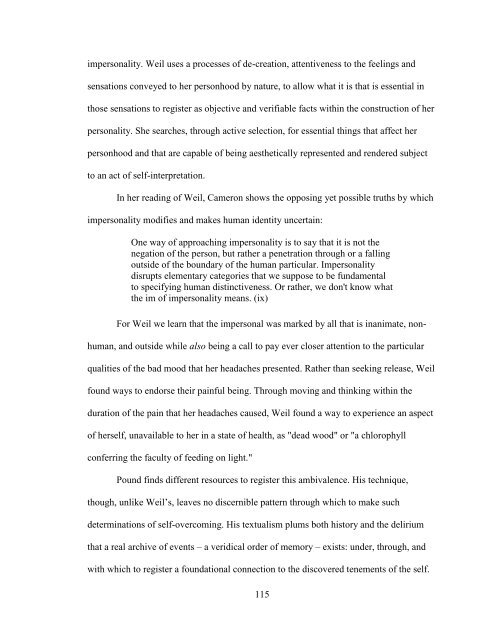TABOO: THE ACTUAL MODERNIST AESTHETIC, MADE REAL A ...
TABOO: THE ACTUAL MODERNIST AESTHETIC, MADE REAL A ...
TABOO: THE ACTUAL MODERNIST AESTHETIC, MADE REAL A ...
Create successful ePaper yourself
Turn your PDF publications into a flip-book with our unique Google optimized e-Paper software.
impersonality. Weil uses a processes of de-creation, attentiveness to the feelings and<br />
sensations conveyed to her personhood by nature, to allow what it is that is essential in<br />
those sensations to register as objective and verifiable facts within the construction of her<br />
personality. She searches, through active selection, for essential things that affect her<br />
personhood and that are capable of being aesthetically represented and rendered subject<br />
to an act of self-interpretation.<br />
In her reading of Weil, Cameron shows the opposing yet possible truths by which<br />
impersonality modifies and makes human identity uncertain:<br />
One way of approaching impersonality is to say that it is not the<br />
negation of the person, but rather a penetration through or a falling<br />
outside of the boundary of the human particular. Impersonality<br />
disrupts elementary categories that we suppose to be fundamental<br />
to specifying human distinctiveness. Or rather, we don't know what<br />
the im of impersonality means. (ix)<br />
For Weil we learn that the impersonal was marked by all that is inanimate, non-<br />
human, and outside while also being a call to pay ever closer attention to the particular<br />
qualities of the bad mood that her headaches presented. Rather than seeking release, Weil<br />
found ways to endorse their painful being. Through moving and thinking within the<br />
duration of the pain that her headaches caused, Weil found a way to experience an aspect<br />
of herself, unavailable to her in a state of health, as "dead wood" or "a chlorophyll<br />
conferring the faculty of feeding on light."<br />
Pound finds different resources to register this ambivalence. His technique,<br />
though, unlike Weil‘s, leaves no discernible pattern through which to make such<br />
determinations of self-overcoming. His textualism plums both history and the delirium<br />
that a real archive of events – a veridical order of memory – exists: under, through, and<br />
with which to register a foundational connection to the discovered tenements of the self.<br />
115
















